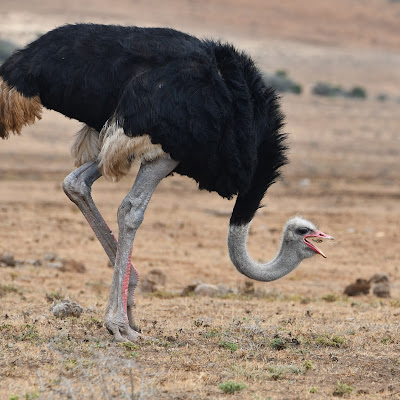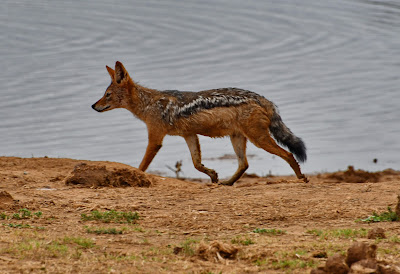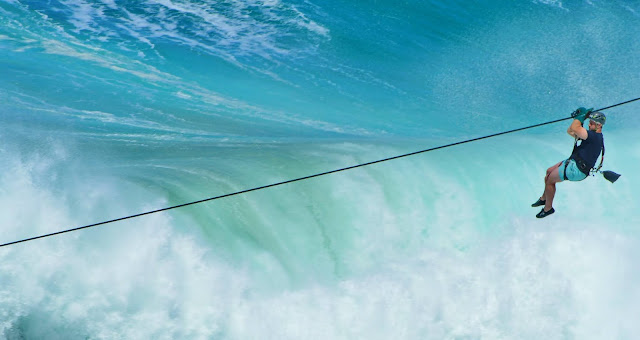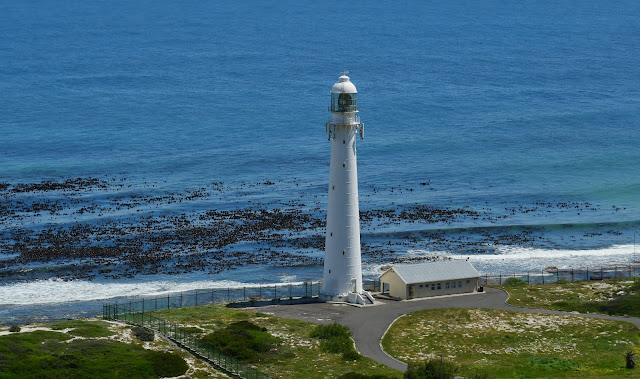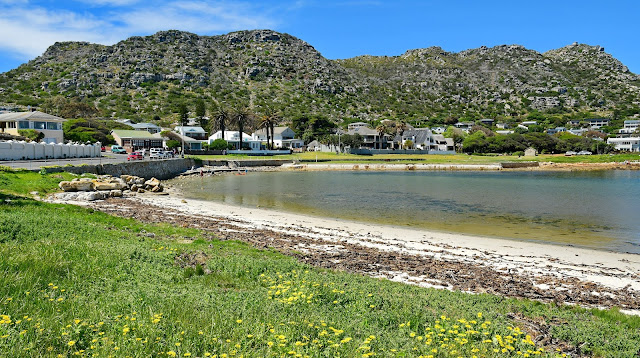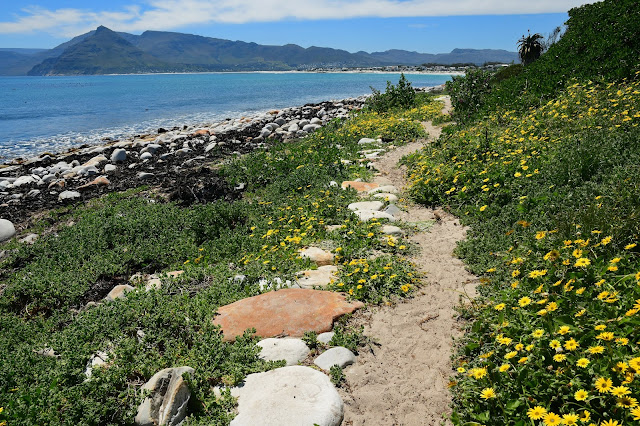50 shades of turquoise.
Mistakenly cited as the point
where the Atlantic and Indian Oceans meet, Cape Point is, nonetheless, a place
like no other. (Incidentally, the two oceans’ meeting point is Cape Agulhas).
In a thunderous clash of water against rock, where mountain and ocean meet,
Cape Point juts out like an outstretched arm, attracting an incredible
diversity of life (furry, feathered and two-legged) to its pristine beaches and
rugged cliffs.
While its
50-shades-of-turquoise-style beaches are the main attraction, Cape Point is a
wonderful day-trip destination for hikers, history buffs and birders alike.
Here are our favourite things to do and
discover at this chronically beautiful national park.
Which are your favourites? We’d
love to hear from you in the comments below.
Important note Although the Cape is rich
in natural beauty, tourists and locals are urged to take necessary precautions
when exploring secluded areas, as crimes and accidents do happen. Those
venturing into Cape Point National Park should have the following
emergency number on hand: 021 780 9010, and also Table Mountain
National Park 086 110 6417/ 107 or 021 480 7700. Criminal incidents
should be reported to the nearest police station as soon as able.
We also recommend @safetymountain
as a useful resource for hikers. This free safety tracking service allows you
to notify local trackers of your contact details, intended route and travel
time via WhatsApp. You are then able to provide hourly updates on your
progress, and to notify trackers when you are safely off the mountain.
Covid-19 safety protocols
·
Wear your
masks at all times. No mask, no entry!
·
Maintain
social-distancing.
·
Sanitise
your hands regularly.
Buffels Bay
Do you speak blue? No? After
spending a day on this crescent-shaped slice of paradise – undoubtedly the
number one reason to visit Cape Point – you’ll be fluent in the entire
spectrum! We’re talking a constantly changing rhapsody of turquoise,
ultramarine, cobalt, electric, azure and navy – starting off as translucent
aquamarine near the shore, and becoming deeper and darker the further you go.
With the odd megayacht punctuating the horizon, you almost expect a buff Daniel
Craig to emerge from the water, in those iconic swim trunks, goggles pulled up
on his head.
On the day we visited, there was a faint, steady breeze, which fortunately
didn’t dampen our picnic, but sent wafts of smoke from nearby braaiers in our
direction! (If you’re planning to braai here or at nearby Bordjiesdrif Beach,
you’ll need to bring your own grid and wood. And don’t feed the baboons!)
With powder-soft sand, a clean, gently lapping ocean as far as the eye can see,
braai and picnic spots aplenty, this rhapsody in blue is well worth the drive.
Walk the shipwreck
trail
Also known as the Olifantsbos
trail, this is a short and easily accessible three-kilometre walk (around one
hour and 30 minutes). It leads through fynbos to the beach where the
prominent SS Thomas T. Tucker, wrecked in 1942. This former WWII
troops-and-weapons transport vessel is Cape Point’s most photographed shipwreck and its
hull is home to local birdlife. Before heading back or continuing to
Sirkelsvlei, rest near the Nolloth, a liquor carrier wrecked in
1965. After that, follow guided tours for more coastline wreckage.
Good to know Though these are year-round trails, the weather can be
rough during winter, and windy in January and February, so check the conditions
before setting out.
Game-spotting at
Cape Point
Cape Point promises hikes, swims
and historical discoveries, but there’s also a plethora of fauna roaming the
park. From baboons carrying their pups on their backs and herds of ostriches
strolling about, animal lovers should keep watch, as the reserve is also home
to a variety of antelope as well as Cape foxes, genets, polecats, mole rats,
porcupines, mongooses, tortoises and snakes. It’s also an excellent
birdwatching site, with over 270 species calling it home. And keep an eye on
the horizon, as you might spot a whale or two during whale season (between
August and October).
Cape of Good Hope
One of the Cape’s most popular
tourist destinations – not just because it’s the most southwestern point on the
African continent – The Cape of Good Hope also happens to be a spectacularly
scenic picnic spot, with a slew of hiking and cycling trails around it. A steep
wooden staircase leads to the lookout point, whose 360-degree views are well
worth the climb.
Good to know The Cape of Good Hope is often mistaken as the
southernmost point of Africa; that title goes to Cape Agulhas. It’s the most
southwestern point.
Coastal foraging
Foraging expert Roushanna Gray
hosts a series of courses across the peninsula aimed at learning, exploring and
sustainably foraging the unique ingredients that abound in our oceans. The Veld
and Sea course starts on the beach, where you get to delve into the freshwater
tidal pools, hunting for edible seaweed, mussels and other gems. Once your
bounty has been collected, you’ll head to the Veld and Sea classroom at Cape
Point, where you’ll help prepare a beautiful outdoor lunch. (Plus, you’ll get to
enjoy the rejuvenating benefits of a seaweed face mask in between your meal
prep!)
Cost From R800 per person
Contact 072 234 4804, veldandsea@gmail.com
Where to find it Good Hope Gardens Nursery, Plateau Road, Cape
Point
View
upcoming events
Platboom Beach
Platboom (Afrikaans for flat
tree) is perhaps the wildest, most unspoilt beach in this national park. With
coastal views, and abundant flora and fauna (including the occasional ostrich
and baboon), the white expanses of sand are largely deserted, making this one
of Cape Town’s most unique and unchartered beaches.
If you’re feeling plucky, explore the chalk-white sand dunes and rocky
outcrops; or simply take a long, undisturbed stroll along the spellbinding
coastline. Due to its secluded setting, swimming is not recommended, but you
can certainly dip your feet into the pristine waters! It’s a great spot for
birdwatching, picnicking and maybe a spot of kite-surfing.
Good to know It’s hidden some 4.9km from the heart of Cape Point
National Park (access runs past Dias Cross, though previous visitors recommend
the north-south hike from Gifkommetjie).
Ride an e-bike
around the tip of Africa
This relaxed e-bike starts with a
southward ride towards the Cape of Good Hope (the most southwestern tip of
Africa), where you can hop off your bike and observe the legendary landmarks
and resident species found here – baboons, ostriches, buck and the Cape mountain
zebra. Then it’s on to Cape Point, where you can glimpse the lighthouse up
close and enjoy the surroundings at your own pace. Once done at Cape Point, you
have the option of going to see the penguins at Boulders Beach in Simon’s Town.
Included in the eight-hour guided tour: entrance fee to Cape Point National
Park, the services of a professional guide, pick-up and drop-off at your
accommodation, water and the rental of a helmet and the electric bike.
Duration 8 hours 30 minutes
When Daily
Cost R1 790 per person (full-day tour)
Please note Minimum age is 12 years.
Where to find it Cape Point National Park (pick up from Cape Town’s
central areas, from hotel or other, provided you give a contact number when
making your booking.
BOOK NOW
Two Oceans
Restaurant at Cape Point
Windswept, rosy-cheeked and
hungry visitors will find a light and airy space at Cape Point’s long-standing
restaurant (it opened its doors in 1995), where large sea-facing windows paint
the picture of Mediterranean summers on the beach. Sit on the deck and drink in
the sea views.
View the menu
Good to know Booking is recommended even outside of peak season.
Opening times Friday – Sunday, 12pm – 4.30pm
The Old Lighthouse
Instead of guiding ships to
safety, Cape Point’s first lighthouse, built in 1859, was often the cause of
mishaps, because of its high perch above the ocean that concealed it among the
clouds.
In 1911 the new lighthouse was built, and remains one of the most powerful
sentinels on the South African coast, with a range of 60 kilometres and a
luminous intensity of 10 million candelas.
From the old lighthouse, breathtaking views of the two oceans and surrounding
coastline can be enjoyed. And, from August to October, you might even catch
sightings of whales although you’ll need to use the onsite binoculars (or bring
your own) to squizz them properly!
The Scone Shack
Made almost entirely out of
recycled windows and scraps of wood, this crooked little shack is a
fairytale-esque dessert spot on a farm on the road to Cape Point. Owned by Karl
Odendaal, who bought the property 30 years ago when he was 21, the farm is also
home to a succulent nursery, a rustic river setup, complete with rowboats and a
rope swing, and a menagerie of farm animals – ducks, Egyptian geese, chickens,
pigs and dogs, to name a few. We visited after a dreamy day on Buffels Bay
Beach, and were greeted by four litters of teeny weeny piglets, whose
protective moms wouldn’t allow us too close.
As for the scones, hands down the best in the Cape, they’re made by Karl’s
partner Cara in a wood-burning oven and served with utterly delicious homemade
jam, butter and cream. The cinnamony ice tea is also delicious!
Please note The Scone Shack only accepts cash.
Opening times Wednesday – Sunday, 9.30am – 5pm
Contact 079 045 1318, lalaphanzik@gmail.com
Where to find it Lalaphanzi Farm, Plateau Road, Cape Point
Diaz Beach
Cape Point’s secret beaches are a
major drawcard for privacy-loving waterbabies who prize seclusion. Diaz Beach
is without a doubt one of Cape Town’s most beautiful, and remains largely
undisturbed due to the 20-minute walk from the parking lot down a steep set of
wooden stairs to the white sands. But for the stunning views alone, it’s
undoubtedly worth it, as Diaz will render you breathless in the best possible
way.
Unfortunately, swimming is off-limits here, due to strong currents.
Good to know Edged by wild fynbos, Olifantsbos Beach bears
testament to the ferocity of the infamous Cape of Storms, with at least three
shipwrecks dotted along its coast. And then there’s Maclear Beach,
probably the most secluded of the lot, reached by following one of two
fynbos-lined footpaths.
Go deep-sea fishing
Feel like an exhilarating
open-ocean adventure? Why not visit Cape Point by boat? There are various trips available,
suited to a variety of tastes and occasions. The two-hour marine eco-tour along
the coastline to Cape Point will appeal to leisure travellers, while serious
fishermen will relish being in the nutrient-rich waters, around 32 to 48
kilometers off Cape Point, where yellowfin, longfin, skipjack and big-eye tuna
abound. Bait and tackle are provided (for the fishing options) and an
experienced guide and a photographer are optional. Snacks and refreshments are
served.
Please note All trips are subject to weather conditions, and number
of passengers.
Good to know The boat tours and fishing charters, all
sustainability-focused, allow up to nine passengers at a time (subject to
social-distancing regulations).
When Daily (weather-permitting)
Cost R1 500 per person (two-hour boat trip)
R6 000 per person (private hire, two-hour boat trip)
R4 000 per person (offshore fishing)
R14 500 (private hire, offshore fishing)
Contact 083 544 6748, alan@capeboatcharters.com
Where to find it Simon’s Town Jetty, Wharf Street, Simon’s Town,
Cape Town
BOOK NOW
Experience Cape
Point from a helicopter
If you’re looking for a visually
immersive tour of this iconic peninsula, hop in a helicopter! The ride takes off
from the V&A Waterfront and flies across the Atlantic over Clifton and
Camps Bay, where you’ll witness exquisite views of Table Mountain and the
Twelve Apostles mountain range on your left. Then, it’s past Hout Bay,
Noordhoek and Kommetjie to Cape Point. The return trip flies along the False
Bay coast: Simon’s Town, Fish Hoek and Muizenberg, passing the wine estates of
Constantia and the cityscape of Cape Town CBD, before landing back at the
V&A Waterfront.
Good to know Tickets are in the form of a voucher that is valid for
three years.
When Monday – Sunday, 8am – 6pm (depending on the flight)
Sharing flights: 10am; 4pm
Please note Arrive 30 minutes before your departure time to
complete ticket information and receive your safety briefing.
Cost R17 700 (1 – 3 passengers)
R23 600 (4 passengers)
R35 400 (5 – 6 passengers)
Where to find it E Pier Road, V&A Waterfront, Cape Town
BOOK NOW
Get a history
lesson
Driving or hiking around Cape
Point, you might stumble upon two tall white pillars with a cross on top. These
monuments were erected in honour of Bartolomeu Dias and Vasco da Gama, two
explorers who passed by and, not surprisingly, fell in love with Cape Point.
While Bartolomeu Dias wasn’t successful in his mission to sail from Europe
around Africa to India, he is one of the most famous explorers to have passed
the Cape. In 1488 after reaching what is believed to be Port Alfred in the
Eastern Cape, he turned his ship around and stumbled upon Cape Point, which he
named Cape of Storms.
After Dias’ unsuccessful quest to reach India, Portuguese King, João II,
ordered Vasco da Gama to complete the trip in 1497. Like Dias, Da Gama
struggled to round Cape Point and only managed on his third attempt in five
days.
Put the funicular
into Cape Point
The Flying Dutchman Funicular is
a schlep-free way to see all the sights on offer at Cape Point. The two
40-seater carriages – which carry a maximum of 10 people during Covid-19 –
travel from the parking lot along an almost-600-metre track through dense
fynbos to the old lighthouse every three minutes! Once at the top (roughly 90
metres above the parking lot), you’re met with spectacular views of the point
and surrounding beaches. Keep a keen eye out for the ghost of the Flying
Dutchman – a ship that was torn to shreds along Cape Point three-and-a-half
centuries ago – still said to sail the nearby seas, desperately seeking aid.
My Green Card
SANParks’ My Green Card allows you 12 entries into
the pay points of the Table Mountain National Park (TMNP) within a one-year
period. If you are a frequent visitor to Cape Point, Boulders, Oudekraal,
Silvermine, and the braai and picnic areas at Tokai, Newlands and Perdekloof,
the card is worth purchasing.
Note The My Green Card may only
be bought by South Africans with an ID number who have proof of a Cape Town
address not older than three months.
Opening times
Monday – Sunday, 7am – 5pm
Contact
021 780 9010, info@capepoint.co.za
021 712 7471, tablem@sanparks.org
Article Courtesy of the Inside Guide
For Accommodation Cape Town, South Africa

